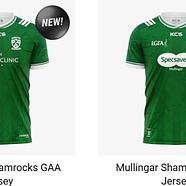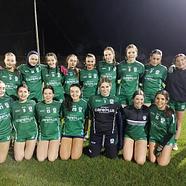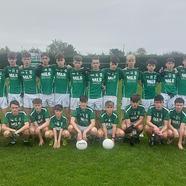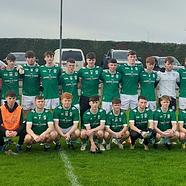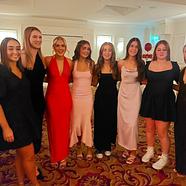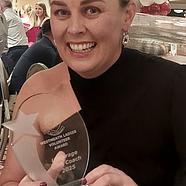Kevin Higgins Remembers ...
Kevin Higgins was an outstanding Mullingar Shamrocks and Westmeath player in the 1960s playing mainly in the half-back line for Shamrocks and in goal for Westmeath. Kevin was the outstanding goalkeeper for the county minor team that won the Leinster title in 1963 and qualified for the All-Ireland final against Kerry where they were well defeated. On this day Kevin Higgins gave a sensational display in goal and established his reputation as a top class goalkeeper. In 1964 and 1966 Kevin was wing-back on the Mullingar Shamrocks senior championship winning teams and was Westmeath goalkeeper from October 1964 until February 1968. He was in goal for Westmeath in one of the county's famous Leinster championship victories when Dublin were defeated 1-6 to 0-8 in 1967 before Meath ended the campaign with an 0-12 to 0-6 victory in July 1967. Not many goalkeepers have faced Dublin and Meath in the Leinster championship without conceding a goal. In 1968 Kevin was selected on the Leinster team for the Railway Cup semi-final against Munster. Again Kevin kept a clean sheet as Munster were defeated. Injury prevented Kevin lining out in the final (his replacement was Martin Furlong) but Shamrocks were still represented in the final as Paddy Cole lined out at right corner back.
Here Kevin Higgins recalls his days playing football in Mullingar in the late 1950s and 1960s.
What attracts a person to one particular sport or game rather than to another brings up the question of nature versus nurture - is it something that's built in or something that's learned? Whichever it may be, I have a very early memory of being guided to kick a tied up ball of newspaper by a family friend, Paddy Duffy, a Longford man working in St Loman's hospital. This may be a real memory or something built around stories told later on. There were the football heroes of the day and with toys and balls littering the kitchen floor I was told that 'Psychey' Dunne wouldn't leave his things scattered like that'.
The Christian Brothers in St Mary's primary school continued the encouragement and there were inter-class leagues and regular after-school games in the field in front of the school. No kit was required; it was normal to play in school clothes; we arrived home at times with knees and clothes so muddy that my mother asked: 'Do you have to fall over when you're playing football'? It was a Brother Egan who came into class on a Monday morning with bruises that we put down to his playing for a local team the day before. In sixth class Br Curtis encouraged the games and involvement in the street leagues that were being organised by the football and hurling clubs. There was great rivalry between the teams from St Brigid's, Patrick Street and Springfield and it was the start of 'representative' play. What put me off a little was when a player, Tony Mulderry, got the full force of the 'sliotar' in a most delicate area of his anatomy. The McCoys of Patrick St., Noel Foran and the Connaughtons from St Brigid's and the Dowd brothers (James, Terry and Dan) from Springfield stand out in memory.
Secondary school (Latin) in the late 1950s brought many changes. Some play mates went to other schools, new friends came into school from surrounding parishes. The games were encouraged but soccer (Peil ar an dTalamh) was certainly not. With a half-day on Wednesdays there was a dedicated time for football and it was Frankie Murray (dedicated soccer fan) and his brother Vinny, who organised a marathon series of games on the bit of ground at the end of Assumption Villas beside Montgomery's. These games continued through a mud filled winter and on occasion we built goals from rolled snow balls. As well as this we raced back to school at lunchtimes for ten or fifteen minutes of football in the school field with the 'country' lads before going sweatily back into class.
School teams were then a possibility but the junior teams had little success. Nevertheless we enjoyed half-days travelling as supporters to watch the senior teams with players like Dave Nolan, James O'Dowd, Newmans and Frank Bennett. By this time we juniors would have been spotted by the local club (Shamrocks) and going with trepidation to a first game (probably under 15) and declining the opportunity to go on as a sub because I felt someone else was better. A memorable game followed in Kilbeggan, when all our winter 'training' paid off. A dark, wet summer evening with the ball like a lump of lead, turned into a major victory, the delight of our mentors and seemed to be fun after all.
The mentors were just the men that picked the teams, before you got to know them as people. Mick Reynolds had a coach building business at The Green Bridge that later became such a venue for serious football discussion that it's hard to know how any work was done. As well as an apprentice that played on the team he had a car (blue Austin A40?). Nearly half of the under-15 team seemed to squash into his car and this, with the assistance of Hart's Hackney from next door, was the way we travelled to games. Jimmy Bennett of the Oval Bar was also involved and long before the days of mobile phones and texting, when even landline phones were a rarity, it's hard to understand how they communicated with players about training and fixtures and such. The (Westmeath) Examiner carried details of important games but notice of training or practice games was often by word of mouth so a caller to the house would give a message: 'Game on Wednesday. Be at Market Square at six.' This was the usual meeting place for away games and on one occasion, in later years, when Jimmy Bennett was acting as driver, the junior team was short a player so he went into goal. After one great save, I called for a pass, he threw it – penalty – goal, and we lost the game! Later, at a more serious level, games and training were notified by post.
The Camp Field was the main venue for training although us 'young lads' didn't appear there very often since most of our football was school based. The Springfield pitch was not acquired 'til later, the early 1960s. Changing rooms (other than Cusack Park) were a rare luxury and two old railway wagons sufficed in the early days of Springfield; the only showers being what fell from the sky. On one wet evening in the Camp Field, when Terry Dowd, in trying to block a kick, was hit on the head with the sodden, wet leather ball the result was his not being able to recall any of the events of the evening on his way home. First aid was not neglected, however, especially in Cusack Park where the sight of Jim Dalton loping across the field to assist a stricken player, one hand holding his Order of Malta cap, the other clutching his satchel, remains clear. Another figure from those times was Peter Lynch. He was an ardent supporter and helper with many of our teams, whose face bore scars of falls due to ill health. When we celebrated the winning of a final (minor or U-15) he didn't deny that it was not lemonade that he drank from a previous winners' cup.
Mick Reynolds seemed to be the one who co-ordinated most of the under-age teams and activities up to minor level, winning the Champioship in 1960 in that grade. He seemed to be a man of immense football knowledge, down-to-earth, with a droll sense of humour. When an acquaintance was described as a 'Fíor Gael' his response was 'Yea, nearly a Hurricane'. Soon after that the Juniors won promotion to senior rank and we minors were then on the fringes of a senior team. That team, mainly 'townies', didn't seem to have many physically big players compared to the likes of St Loman's (our nearby rivals that often recruited from the Garda force in town). There were exceptions such as Mick Lynch, who usually played at full forward as well as 'out of towners' such as Brendan McNamara (Mayo) and Gerry Galvin (Kerry) who were solid defenders of some stature. Lacking inches, if not strength, was 'Sonny' Mullen in the full back line. His presence, behind a half-back like myself, meant that any mistakes were tidied up and boosted confidence. In goal, for a few years before Noel Daly, was Tony Caulfield and he was the essence of nonchalance. In one practice game, in his peaked cap, chatting to the umpire and spectators while leaning against the post, smoking a cigarette, an attack was mounted. A shot is taken; he saves and clears the ball. He then goes back to chat, with the butt still in his mouth!
Other qualities may have compensated for such shortcomings of physique. Few players could outjump Frankie Connaughton in the half backs and his skills and accuracy with place kicks were a joy to behold.. In our senior years at Coláiste Mhuire it was Bro McGrath who encouraged the development of our playing skills but the agility and athleticism of many of the players may have been nurtured and developed by the 'street football' of 'White Hart Lane', as Maurice Synnott has pointed out (as Gaeilge in some school publication). This laneway to Presentation Convent, beside the cathedral gates, was the venue for hours and hours of intense after school 'football' – about 5-a-side, soccer, using a tennis ball – in the tight confines of the lane. To play on a wide open field after that was simplicity itself and may have benefitted a number of our players. Since there was very little coaching in any modern sense, the idea was to get to the ball first before your opponent and then give it to a teammate. To catch the ball before it bounced was allied to this. The story was told of one of our stalwart players, Paddy Cole, out of position for a 'big' dropping ball, shouts 'Let it hop and we'll all get it'.
Of course we regarded our nearby rivals, St Loman's, with a lot of respect and some of their players had performed at the highest levels of the game and travelled by Springfield on their way to work. We seemed to play against them mainly in challenge or practice games. Paddy Flanagan, their usual full-back and a great supporter of Mullingar football, had a place kick to match Cluxton's. Expecting his usual kick-out during one practice game, to our annoyance he tapped the ball a few yards then ran and raised it himself and booted it from his hands to a team mate. Even the ref on the day wasn't sure if it was a legal ploy but after a few repetitions we coped with it.
The respect may not have been reciprocated. The popular kit bag of the day was a small stringed duffle bag slung over the shoulder. We were incensed to hear that Loman's thought that 'all they're any good for is carrying duffle bags'! In any event we managed to win the County senior Championship in 1964, maybe against the odds, and again, decisively, in 1966.
The teams of the time may have sounded like a 'Band of Brothers'; the Dalys from Patrick St.; the Connaughtons from St Brigid's (Frank, and Colm brought back from Holland for a final – he hadn't signed for Ajax!); the Magees from St Brigid's (Hubie, with tricks and flicks at corner forward and Sean's athleticism); the O'Dowds (Jimmy, Terry and Dan, solid in all positions).
Of course there were others who contributed hugely to the teams at the time and it would be great to hear their accounts of playing in the 1950s and '60s. Some, for reasons of employment or education, moved away from town in the mid '60s and in my own case a road traffic accident put an end to my serious involvement in the game around that time.


